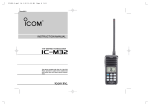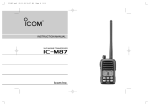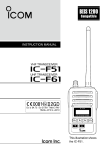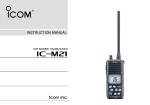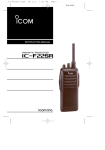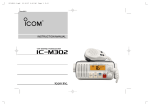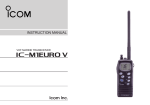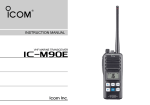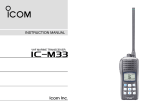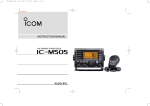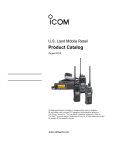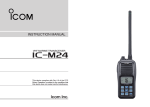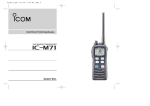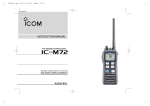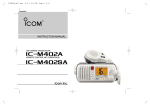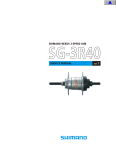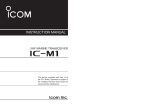Download INSTRUCTION MANUAL
Transcript
IC-M31.qxd 03.10.20 9:18 AM Page 1 (1,1) New2001 INSTRUCTION MANUAL VHF MARINE TRANSCEIVER iM31 IC-M31.qxd 03.10.20 9:18 AM Page i (1,1) New2001 IN CASE OF EMERGENCY RECOMMENDATION If your vessel requires assistance, contact other vessels and the Coast Guard by sending a distress call on Channel 16. CLEAN THE TRANSCEIVER THOROUGHLY WITH FRESH WATER after exposure to saltwater, and dry it before operation. Otherwise, the transceiver’s keys, switches and controllers may become inoperable due to salt crystallization. ❍ USING CHANNEL 16 DISTRESS CALL PROCEDURE 1. “MAYDAY MAYDAY MAYDAY.” 2. “THIS IS ...........................” (name of vessel) 3. Your call sign or other indication of the vessel. 4. “LOCATED AT .....................” (your position) 5. The nature of the distress and assistance required. 6. Any other information which might facilitate the rescue. i IC-M31.qxd 03.10.20 9:18 AM Page ii (1,1) New2001 FOREWORD FEATURES Thank you for purchasing this Icom product. The IC-M31 VHF MARINE TRANSCEIVER is designed and built with Icom’s state of the art technology and craftsmanship. With proper care this product should provide you with years of trouble-free operation. ☞ Waterproof construction Built tough to withstand the punishing marine environment, the IC-M31 meets JIS waterproof specification grade 7 while using BP-223 (option) or BP-224. ☞ Dualwatch and tri-watch functions IMPORTANT READ ALL INSTRUCTIONS carefully and com- pletely before using the transceiver. SAVE THIS INSTRUCTION MANUAL—This instruction manual contains important operating instructions for the IC-M31. EXPLICIT DEFINITIONS WORD DEFINITION Personal injury, fire hazard or electric shock RWARNING may occur. CAUTION NOTE Equipment damage may occur. Convenient functions which allow you to monitor the distress channel (Ch 16) while receiving a channel of your choice—dual watch; or monitor the distress channel and another channel while receiving a channel of your choice—tri-watch. ☞ Large, easy-to-read LCD With dimensions of 16(H) × 32(W) mm, the IC-M31’s function display is easy to read and shows operating conditions at a glance. Backlighting and contrast can be adjusted to suit your preferences. ☞ Simple operation 9 large buttons on the front panel provide user-friendly operation. The independent volume and channel buttons are located on the front panel for convenient one-hand operation. If disregarded, inconvenience only. No risk of personal injury, fire or electric shock. ii IC-M31.qxd 03.10.20 9:18 AM Page iii (1,1) New2001 PRECAUTION RWARNING! NEVER connect the transceiver to an AC outlet. This may pose a fire hazard or result in an electric shock. BE CAREFUL! The transceiver’s right-side panel will become hot when operating continuously for long periods. antenna is very close to, or touching exposed parts of the body, especially the face or eyes, while transmitting. The transceiver will perform best if the microphone is 5 to 10 cm away from the lips and the transceiver is vertical. BE CAREFUL! The IC-M31 employs waterproof construction, which corresponds to JIS waterproof specification, Grade 7 (1 m depth for 30 min.). However, once the transceiver has been dropped, waterproofing cannot be guaranteed due to the fact that the transceiver may be cracked, or the waterproof seal damaged, etc. NEVER MAKE SURE the flexible antenna, top panel and battery RWARNING! NEVER hold the transceiver so that the connect the transceiver to a power source other than the BP-223 or BP-224. Such a connection will ruin the transceiver. AVOID using or placing the transceiver in direct sunlight or in areas with temperatures below –15°C or above +55°C. pack are securely attached to the transceiver, and that the antenna, top panel and battery pack are dry before attachment. Exposing the inside of the transceiver to water will result in serious damage to the transceiver. KEEP the transceiver out of the reach of children. KEEP the transceiver at least 0.9 meters away from your vessel’s magnetic navigation compass. Icom, Icom Inc. and the logo are registered trademarks of Icom Incorporated (Japan) in the United States, the United Kingdom, Germany, France, Spain, Russia and/or other countries. iii IC-M31.qxd 03.10.20 9:18 AM Page iv (1,1) New2001 TABLE OF CONTENTS IN CASE OF EMERGENCY ................................................ i RECOMMENDATION ........................................................... i FOREWORD ....................................................................... ii IMPORTANT ........................................................................ ii EXPLICIT DEFINITIONS ..................................................... ii FEATURES .......................................................................... ii PRECAUTION .................................................................... iii TABLE OF CONTENTS ...................................................... iv 1 OPERATING RULES ...................................................... 1 2 SUPPLIED ACCESSORIES AND ATTACHMENTS.... 2–3 ■ Supplied accessories ................................................... 2 ■ Attachments ................................................................. 2 3 PANEL DESCRIPTION ............................................... 4–6 ■ Front, top and side panels............................................ 4 ■ Function display .......................................................... 5 4 BASIC OPERATION ................................................. 7–12 ■ Channel selection ........................................................ 7 ■ Adjusting the volume level ........................................... 9 ■ Adjusting the squelch level .......................................... 9 ■ Receiving and transmitting ........................................ 10 ■ Call channel programming ......................................... 11 ■ Lock function ............................................................. 12 ■ Automatic backlighting .............................................. 12 ■ Monitor function ......................................................... 12 5 SCAN OPERATION ................................................ 13–14 ■ Scan types ................................................................. 13 ■ Setting tag channels .................................................. 14 ■ Starting a scan .......................................................... 14 6 DUALWATCH/TRI-WATCH .......................................... 15 ■ Description ................................................................ 15 ■ Operation ................................................................... 15 7 SET MODE ............................................................. 16–20 ■ SET mode programming ........................................... 16 ■ SET mode items ........................................................ 17 8 BATTERY CHARGING ........................................... 21–24 ■ Battery charging ........................................................ 21 ■ Battery cautions ......................................................... 21 ■ Optional battery case ................................................ 22 ■ Optional battery chargers .......................................... 23 9 OPTIONAL SWIVEL BELT CLIP ........................... 25–26 ■ MB-87 contents ......................................................... 25 ■ To attach .................................................................... 25 ■ To detach ................................................................... 26 10 TROUBLESHOOTING ................................................ 27 11 CHANNEL LIST ........................................................... 28 12 SPECIFICATIONS AND OPTIONS .............................. 29 13 DOC.............................................................................. 30 iv IC-M31.qxd 03.10.20 9:18 AM Page 1 (1,1) New2001 1 OPERATING RULES D Priorities • Read all rules and regulations pertaining to priorities and keep an up-to-date copy handy. Safety and distress calls take priority over all others. • You must monitor Channel 16 when you are not operating on another channel. (2) OPERATOR’S LICENSE A restricted Radiotelephone Operator Permit is the license most often held by small vessel radio operators when a radio is not required for safety purposes. The Restricted Radiotelephone Operator Permit must be posted near the transceiver or be kept with the operator. Only a licensed radio operator may operate a transceiver. • False or fraudulent distress calls are prohibited under law. D Privacy • Information overheard but not intended for you cannot lawfully be used in any way. • Indecent or profane language is prohibited. D Radio licenses (1) SHIP STATION LICENSE When your craft is equipped with a VHF FM transceiver, you must have a current radio station license before using the transceiver. It is unlawful to operate a ship station which is not licensed. Inquire through your dealer or the appropriate government agency for a Ship-Radiotelephone license. This license includes the call sign which is your craft’s identification for radio purposes. 1 However, non-licensed individuals may talk over a transceiver if a licensed operator starts, supervises, ends the call and makes the necessary log entries. A current copy of the applicable government rules and regulations is only required to be on hand for vessels in which a radio telephone is compulsory. However, even if you are not required to have these on hand it is your responsibility to be thoroughly acquainted with all pertinent rules and regulations. IC-M31.qxd 03.10.20 9:18 AM Page 2 (1,1) SUPPLIED ACCESSORIES AND ATTACHMENTS ■ Supplied accessories The following accessories are supplied: Qty. • Flexible antenna . . . . . . . . . . . . . . . . . . . . . . . . . . . . . . . . 1 • Handstrap . . . . . . . . . . . . . . . . . . . . . . . . . . . . . . . . . . . . . 1 • Belt clip (MB-68) . . . . . . . . . . . . . . . . . . . . . . . . . . . . . . . . 1 • Ni-Cd battery pack (BP-224) . . . . . . . . . . . . . . . . . . . . . . 1 • Battery charger (BC-150) . . . . . . . . . . . . . . . . . . . . . . . . . 1 • Screws for the BC-150 (M3.5 × 20) . . . . . . . . . . . . . . . . . 2 • AC adapter (BC-147E)*1 . . . . . . . . . . . . . . . . . . . . . . . . . . 1 • Top panel/Top sheet (double-sided tape)*2 . . . . . . . . . 1 set *1 Not supplied with some versions. *2 Use the top panel with top sheet as a spare. Ask your dealer for details. 2 D Handstrap 1 2 Pass the handstrap through the loop on the side of the transceiver as illustrated at right. Facilitates carrying. D Belt clip Attach the belt clip to the transceiver as illustrated below. To attach the belt clip ■ Attachments D Flexible antenna To remove the belt clip Connect the supplied flexible antenna to the antenna connector. CAUTION! • NEVER HOLD by the antenna when carrying the transceiver. • Transmitting without an antenna may damage the transceiver. Top panel 2 03.10.20 9:18 AM Page 3 (1,1) New2001 2 SUPPLIED ACCESSORIES AND ATTACHMENTS ï Battery pack To remove the battery pack: Turn the screw counterclockwise, then pull the battery pack in the direction of the arrow as shown below. NOTE: When removing or attaching the battery pack, use a coin or flat-blade screwdriver to loosen or tighten the bottom screw. To attach the battery pack: Insert the battery pack in the IC-M31 completely, then turn the screw clockwise. CAUTION!: When attaching or removing a battery pack, make sure the rubber seal is set in the groove of the battery pack correctly. If the seal is not neatly in the groove it may be damaged when attaching the battery pack. If the seal is damaged, waterproofing is not guaranteed. NEVER remove or insert the battery pack when the transceiver is wet or soiled. This may result water or dust getting into the transceiver/battery pack and may result in the transceiver being damaged. NOTE: When attaching a battery pack, make sure dust or else does not adhere to the rubber seal. If dust or else is on the seal when attaching a battery pack, the water resistant may be reduced. Make sure both the rubber seal (purple) is set to the groove correctly and dust or else does not adhere to it. LO CK Screw position when removing battery OPEN Incorrect position Correct position Rubber seal CK Screw position when attaching battery LO IC-M31.qxd OPEN Groove Battery pack 3 Battery pack IC-M31.qxd 03.10.20 9:18 AM Page 4 (1,1) PANEL DESCRIPTION 3 ■ Front, top and side panels q w q POWER SWITCH [PWR] Push and hold to turn power ON and OFF. 2 3 w ANTENNA CONNECTOR (p. 2) Connects the supplied antenna. !0 Speaker Microphone Function display (p. 5) o i u e r t y e SCAN/DUAL KEY [SCN•DUAL] • Starts and stops normal or priority scan. (p. 14) • Enters watch mode when pushed for 1 sec. (p. 15) • Exits watch mode when pushed during watch operation. (p. 15) r TRANSMIT POWER/LOCK KEY [H/L•LOCK] • Selects high or low power when pushed. (p. 10) • Toggles the lock function ON/OFF when pushed for 1 sec. (p. 12) t VOLUME UP/DOWN KEYS [+]/[–]•[VOL] • Adjusts the volume level. (p. 9) • After pushing [SQL•MONI], push to adjust the squelch level. (p. 9) y SQUELCH KEY [SQL•MONI] • Push this key, then adjust the squelch level with [+]/[–]. (p. 9) • Manually opens the squelch for monitoring the channel while pushed and held. (p. 12) • While pushing this key, turn power ON to enter the set mode. (p. 16) ☞ Continue to the next page. 4 IC-M31.qxd 03.10.20 9:18 AM Page 5 (1,1) New2001 3 PANEL DESCRIPTION ■ Front, top and side panels (Continued) Y]/[Z Z]•[TAG] u CHANNEL UP/DOWN KEYS [Y • Selects an operating channel. (pgs. 7, 8) • Selects the SET mode condition of the item. (p. 16) • Checks tag channels or changes scanning direction during scan. (p. 14) • Sets or clears the displayed channel as a tag (scanned) channel when pushed both keys for 1 sec. (p. 14) • While pushing this key, turn power ON to clear all tag channels in the channel group. (p. 14) i DIAL/CHANNEL GROUP KEY [DIAL] • Push to return to the channel selection before selecting the channel 16 or the call channel with [16•C]. • Selects one of 2 regular channel groups in sequence when pushed for 1 sec. (p. 8) - International, U.S.A.*1 (or ATIS*2) channels are available. *1 Available for the UK version only *2 Available for the German version only o CHANNEL 16 KEY [16•C] • Selects Channel 16 when pushed. (p. 7) • Selects the call channel when pushed for 1 sec. (p. 7) • Enters call channel programming condition when the call channel is selected and this key is pushed for 3 sec. (p. 11) • Exits set mode when pushed during set mode operation. (p. 16) !0 PTT SWITCH [PTT] Push and hold to transmit; release to receive. 5 ■ Function display q w e r t y u i o !7 !0 !6 !1 !2 !5 !4 !3 q TRANSMIT INDICATOR (p. 10) Appears while transmitting. w BUSY INDICATOR Appears when receiving a signal or when the squelch opens. (p. 10) “ ” blinks while monitoring. (p. 12) e TAG CHANNEL INDICATOR (p. 14) Appears when a tag channel is selected. r CALL CHANNEL INDICATOR (p. 7) Appears when the call channel is selected. IC-M31.qxd 03.10.20 9:18 AM Page 6 (1,1) New2001 PANEL DESCRIPTION t LOCK INDICATOR (p. 12) Appears while the lock function is activated. !1 SQUELCH LEVEL INDICATOR Shows the squelch level. y BATTERY INDICATOR Indicates remaining battery power. !2 VOLUME LEVEL INDICATOR Shows the volume level. Full Middle Charging required 3 !3 VOLUME LEVEL ADJUSTING INDICATOR Blinks while adjusting the volume level. Indication Battery level 3 No battery blinks when the battery over charged. blinks when the battery is exhaustion. u SCAN INDICATOR (p. 14) Blinks while scanning. i DUALWATCH/TRI-WATCH INDICATORS (p. 15) “DUAL” appears during dualwatch; “TRI” appears during tri-watch. o DUPLEX INDICATOR Appears when a duplex channel is selected. !0 SUB CHANNEL READOUT • Indicates Channel 16 during priority scan, dualwatch or tri-watch. (p. 15) • Indicates the SET mode item while in SET mode. (p. 16) • Indicates the squelch level while squelch setting. (p. 9) • Indicates the volume level while volume setting. (p. 9) !4 SQUELCH LEVEL ADJUSTING INDICATOR Blinks while adjusting the squelch level. !5 CHANNEL NUMBER READOUT • Indicates the selected operating channel number. • In SET mode, indicates the selected condition. !6 CHANNEL GROUP INDICATOR (p. 8) “I” appears when International; “U” appears when U.S.A. (U.K. version only); “ATIS” appears when the channel group in which ATIS function is activated (German version only). !7 LOW POWER INDICATOR (p. 10) • “LOW” appears when low power is selected. • “LOW” blinks when switching forced low power mode because of a high temperature error or low voltage. 6 IC-M31.qxd 03.10.20 9:18 AM Page 7 (1,1) New2001 New2001 4 BASIC OPERATION ■ Channel selection IMPORTANT!: Prior to using the transceiver for the first time, the battery pack must be fully charged for optimum life and operation. To avoid damage to the transceiver, turn the power OFF while charging. D Channel 16 Channel 16 (Distress channel) is used for establishing initial contact with another station and for emergency communications. Channel 16 is automatically monitored during both dualwatch and tri-watch. While standing by, you must monitor Channel 16. q Push [16•C] to select Channel 16. w Push [DIAL] to return to the condition before selecting Channel 16, or push [Y]/[Z] to select the operating channel. D Call channel Each regular channel group has a separate call channel. In addition, the call channel is monitored during tri-watch. The call channels can be re-programmed (p. 11) and are used to store your most often used channels in each channel group for quick recall. q Push [16•C] for 1 sec. to select the call channel in the selected channel group. • “CALL” and the call channel number appear. • Each channel group may have its own call channel after programming a call channel. See the “Call channel programming” on p. 11 for details. w Push [DIAL] to return to the condition before selecting the call channel, or push [Y]/[Z] to select the operating channel. C C Push Push for 1 sec. Channel 16 is the default setting. (depending on version) 7 IC-M31.qxd 03.10.20 9:18 AM Page 8 (1,1) New2001 BASIC OPERATION 4 D International, U.S.A.*1 and ATIS*2 channels There are 57 (58)*1 International, 58 U.S.A.*1 and 57 ATIS*2 channels. These channel groups may be specified for the operating area. 4 q Push [DIAL] to select a regular channel. w Push [Y]/[Z] to select a channel. • “DUP” appears for duplex channels. e To change the channel group, push [DIAL] for 1 sec. • International, U.S.A.*1 and ATIS*2 channels can be selected in sequence. Push International channels for 1 sec. U.S.A channels*1 Push for 1 sec. ATIS channels*2 *1 Available for the UK version only *2 Available for the German version only 8 IC-M31.qxd 03.10.20 9:18 AM Page 9 (1,1) New2001 4 BASIC OPERATION ■ Adjusting the volume level ■ Adjusting the squelch level The volume level can be adjusted with [+]/[–]. The IC-M31 has a squelch level adjustment, even though there is no control knob for it. In order to receive signals properly, as well as for the scan to function effectively, the squelch must be adjusted to the proper level. q Push [SQL•MONI], then adjust the squelch level with [+]/[–]. ➥ Push [+]/[–] to adjust the volume level. • “VOL” indicator starts blinking. • There are 32 volume levels to choose. • When no key is pushed for 5 sec., the transceiver returns to normal condition. Indicates the volume level. - “SQL” indicator starts blinking. - There are 11 squelch levels to choose from: “OP” is completely open; “10” is tight squelch; “1” is loose squelch level. - When no key is pushed for 5 sec., the transceiver returns to normal condition. Blinks during volume level adjustment. Indicates the squelch level. Blinks during squelch level adjustment. w Push [SQL•MONI] again to return to normal condition. ✔ CONVENIENT! The squelch level adjustment key can be selected from [Y]/[Z] and [+]/[–] with following operation. • While pushing both [SQL•MONI] and [Y], turn the power ON to set [Y]/[Z] to the squelch level adjustment key. • While pushing both [SQL•MONI] and [+], turn the power ON to set [+]/[–] to the squelch level adjustment key. 9 IC-M31.qxd 03.10.20 9:18 AM Page 10 (1,1) New2001 BASIC OPERATION 4 ■ Receiving and transmitting CAUTION: Transmitting without an antenna may damage the transceiver. q Push and hold [PWR] to turn power ON. w Set the volume and squelch levels. ➥ Push [SQL•MONI], and push [–] to open the squelch. ➥ Push [SQL•MONI] to stop “SQL” indicator blinking, then push [+]/[–] to set the volume level. ➥ Push [SQL•MONI], and push [+]/[–] to set the squelch level. e Push [Y]/[Z] to select the desired channel. - When receiving a signal, “ ” appears and audio is emitted from the speaker. - Further adjustment of the volume may be necessary at this point. r Push [H/L•LOCK] to select the output power if necessary. - “LOW” appears when low power is selected; no indication when high power is selected. - Choose low power to conserve battery power, choose high power for longer distance communications. - Some channels are for low power only. t Push and hold [PTT] to transmit, then speak into the microphone. - “ ” appears. - Channel 70 cannot be used for transmission. y Release [PTT] to receive. IMPORTANT: To maximize the readability of your transmitted signal, pause a few sec. after pushing [PTT], hold the microphone 5 to 10 cm from your mouth and speak into the microphone at a normal voice level. 4 NOTE: The transceiver has a power save function to conserve the battery power. The power save function activates automatically when no signal is received for 5 sec. t Push to transmit y Release to receive Microphone e Set channel q Power ON r Set output power w Set volume w Set the squelch level w Set the squelch level 10 IC-M31.qxd 03.10.20 9:18 AM Page 11 (1,1) New2001 4 BASIC OPERATION ■ Call channel programming The call channel key is used to select the default channel, however, you can program your most often-used channel in each channel group for quick recall. q Push [DIAL] for 1 sec. several times to select the desired channel group (INT, USA, ATIS) to be programmed. w Push [16•C] for 1 sec. to select the call channel. • “CALL” and call channel number appear. e Push [16•C] again for 3 sec. (until a long beep changes to 2 short beeps) to enter call channel programming condition. • Call channel number to be programmed flashes. r Push [Y]/[Z] to select the desired channel. 11 t Push [16•C] to program the displayed channel as the call channel. • The call channel number stop flashing. IC-M31.qxd 03.10.20 9:18 AM Page 12 (1,1) New2001 BASIC OPERATION 4 ■ Lock function ■ Monitor function This function electronically locks all keys (except for [+]/[–], [PTT], [SQL•MONI] and [H/L•LOCK]) to prevent accidental channel changes and function access. The monitor function releases the noise squelch mute. See p. 18 for details of the monitor switch action. ➥ Push [H/L•LOCK] for 1 sec. to turn the lock function ON and OFF. ➥ Push [SQL•MONI] for 1 sec. to activate the monitor function. •“ ” blinks and audio is emitted. Blinks while the monitor function is used. Appears while the lock function is used. LOCK Push for 1 sec. 4 MONI Push for 1 sec. ■ Automatic backlighting This function is convenient for nighttime operation. The automatic backlighting can be activated in SET mode. (p. 18) ➥ Push any key except for [PTT] to turn the backlighting ON. • The backlighting is automatically turned OFF after 5 sec. of inactivity. 12 IC-M31.qxd 03.10.20 9:18 AM Page 13 (1,1) New2001 5 SCAN OPERATION ■ Scan types Scanning is an efficient way to locate signals quickly over a wide frequency range. The transceiver has priority scan and normal scan. In addition, an auto scan function is available for standby convenience. PRIORITY SCAN CH 02 CH 16 CH 05 CH 01 CH 03 CH 04 Priority scan searches through all tag channels in sequence while monitoring Channel 16. When a signal is detected on Channel 16, scan pauses until the signal disappears; when a signal is detected on a channel other than Channel 16, scan becomes dualwatch until the signal disappears. 13 Choose priority or normal scan in SET mode. (p. 17) NORMAL SCAN CH 01 CH 88 Set the tag channels (scanned channel) before scanning. Clear the tag channels which inconveniently stop scanning, such as digital communications. CH 02 CH 88 CH 03 CH 05 CH 04 Normal scan, like priority scan, searches through all tag channels in sequence. However, unlike priority scan, Channel 16 is not checked unless Channel 16 is set as a tag channel. IC-M31.qxd 03.10.20 9:18 AM Page 14 (1,1) New2001 SCAN OPERATION 5 ■ Setting tag channels ■ Starting a scan For more efficient scanning, add desired channels as tag channels or clear the tag for unwanted channels. Non-tag channels will be skipped during scanning. Tag channels can be assigned to each channel group (INT, USA, ATIS) independently. (Depending on version) Set the priority scan function, scan resume timer and auto scan function in advance, using SET mode. (pgs. 17, 18) q Select the desired channel group (INT, USA, ATIS) by pushing [DIAL] for 1 sec., if desired. w Select the desired channel to set as a tag channel. e Push both [Y] and [Z] for 1 sec. to set the displayed channel as a tag channel. •“ ” appears in the function display. r To cancel the tag channel setting, push both [Y] and [Z] for 1 sec. •“ ” disappears. ✔ Clearing all tag channels in the selected channel group While pushing and holding both [Y] and [Z], turn power ON to clear all tag channels in the channel group. [Example]: Starting a normal scan. Scan starts. q Select the desired channel group (INT, USA, ATIS) by pushing [DIAL] for 1 sec., if desired. (Available for the UK and German version only) w Push [SCN•DUAL] to start priority or normal scan. 5 • “SCAN” blinks in the function display. • “16” appears on the sub channel readout during priority scan. • When a signal is received, scan pauses until the signal disappears or resumes after pausing 5 sec. according to scan resume timer setting. (Channel 16 is still monitored during priority scan.) • Push [Y]/[Z] to check the scanning tag channels, change the scanning direction or resume the scan manually. e To stop the scan, push [SCN•DUAL]. • “SCAN” disappears. • Pushing [PTT], [16•C] or [DIAL] also stops the scan. Receiving a signal and audio is emitted. Push Push DUAL DUAL to stop the scan 14 IC-M31.qxd 03.10.20 9:18 AM Page 15 (1,1) New2001 New2001 6 DUALWATCH/TRI-WATCH ■ Description ■ Operation Dualwatch monitors Channel 16 while you are receiving another channel; tri-watch monitors Channel 16 and the call channel while receiving another channel. q Select the desired operating channel. w Push [SCN•DUAL] for 1 sec. to start dualwatch or tri-watch (depending on SET mode setting). DUALWATCH/TRI-WATCH SIMULATION Call channel • “DUAL” blinks during dualwatch; “TRI” blinks during tri-watch. • A beep tone sounds when a signal is received on Channel 16. • Tri-watch becomes dualwatch when receiving a signal on the call channel. e To cancel dualwatch/tri-watch, push [SCN•DUAL] again. [Example]: Operating tri-watch on INT channel 07. DUAL Tri-watch starts. Push for 1 sec. Dualwatch Tri-watch • If a signal is received on Channel 16, dualwatch/tri-watch pauses on Channel 16 until the signal disappears. • If a signal is received on the call channel during tri-watch, tri-watch becomes dualwatch until the signal disappears. • To transmit on the selected channel during dualwatch/triwatch, push and hold [PTT]. Signal is received on the call channel. Signal received on Channel 16 takes priority. Tri-watch resumes after the signal disappears. 15 IC-M31.qxd 03.10.20 9:18 AM Page 16 (1,1) New2001 SET MODE 7 ■ SET mode programming D SET mode operation SET mode is used to change the condition of 11 transceiver functions: beep tone function, priority scan function, scan resume timer, auto scan function, dual/tri-watch function, monitor switch action, automatic backlighting, LCD contrast selection, power save function, self check function and battery voltage indicator. q Turn power OFF. w While pushing [SQL•MONI], turn power ON to enter SET mode. • “bp” appears. e Push [SQL•MONI] or [SQL•MONI] and [Y] to select the desired item, if necessary. r Push [Y]/[Z] to select the desired condition of the item. t To exit SET mode, push [16•C]. 6 7 D SET MODE ITEMS The displays show the default settings, and the selected item is displayed in the dotted circle. Beep tone Priority scan Scan resume timer Starting item Auto scan Dual/Tri-watch Monitor switch MONI : Push MONI : Push Battery voltage Self check and Power save LCD contrast Auto backlight 16 IC-M31.qxd 03.10.20 9:18 AM Page 17 (1,1) New2001 7 SET MODE ■ SET mode items D Beep tone function “bP” D Priority scan function “Pr” You can select silent operation by turning the beep tones OFF, or you can have 2 types of confirmation beeps sound at the push of a switch. When ON is selected, a fixed beep (Pi) sounds, and when US is selected, the preset beeps (e.g. do, re, mi) sound. The transceiver has 2 scan types—normal (OFF) and priority (ON) scans. Normal scan searches all tag channels in the selected channel group. Priority scan searches all tag channels in sequence while monitoring Channel 16. • Beep tone synchronises with the volume level. • The beeps sound during call channel programming even if this function is turned OFF. Push Priority scan (default) Normal scan D Scan resume timer “St” User beep Push Beep tone ON (default) The scan resume timer can be set as a pause (OFF) or timer scan (ON). When OFF is selected, the scan pauses until a received signal disappears. When ON is selected, the scan pauses for 5 sec. after receiving a signal and then resumes even if the signal has been received. Beep tone OFF Push Scan resume timer OFF (default) 17 Scan resume timer ON IC-M31.qxd 03.10.20 9:18 AM Page 18 (1,1) New2001 SET MODE 7 D Auto scan function “AS” D Monitor switch action “Sq” The auto scan function starts the desired scan automatically when no signal is received, and no operation is performed for 30 sec. The monitor switch action cuts off the squelch function temporarily. This switch action contains PUSH (Pu) or HOLD (Ho) settings as shown below. Push • Pu (PUSH): After pushing the [SQL•MONI] for 1 sec., the squelch opens and emits audio. The squelch is held open while continuously pushing and holding [SQL•MONI]. (default) • Ho (HOLD): After pushing the [SQL•MONI] for 1 sec., the squelch opens and emits audio even [SQL•MONI] is released. To close the squelch, push any key. Auto scan OFF (default) Auto scan ON 7 D Dual/Tri-watch function “dt” Push This item selects dual or tri-watch as desired. See p. 15 for details. Push setting (default) Push Dualwatch function (default) Hold setting D Automatic backlighting “bL” Tri-watch function This function is convenient for nighttime operation. The automatic backlighting turns the backlighting ON when any key except for [PTT] is pushed. • The backlighting is automatically turned OFF after 5 sec. of inactivity. Push Auto backlighting ON (default) Auto backlighting OFF 18 IC-M31.qxd 03.10.20 9:18 AM Page 19 (1,1) New2001 7 SET MODE D LCD contrast selection “LC” D Self check function “SC” The contrast of the LCD can be turned ON (high contrast) and OFF (low contrast). The self check function checks transceiver conditions by itself, and informs you in case a problem is found. The following items are checked after the power is turned ON, then it switches to operation mode. • Temperature : Outside of –25°C to +65°C (approx.) • Connected battery voltage • Water intrusion Push LCD contrast ON (default) LCD contrast OFF Push D Power save function “PS” The power save function reduces current drain by deactivating the receiver circuit for preset intervals. Self check OFF (default) • ON : The power save function is turned ON. The power save function will activate when no signal is received, and no operation is performed for 5 sec. • OFF: The power save function is turned OFF. When error messages as shown below are displayed, see troubleshooting for advice. (p. 27) Self check ON Push Temperature error Power save ON (default) 19 Power save OFF Battery voltage error Water intrusion error IC-M31.qxd 03.10.20 9:18 AM Page 20 (1,1) New2001 SET MODE D Battery voltage indicator “bt” SET MODE LIST The voltage of the connected battery pack can be turned ON (displayed for 2 sec.) or OFF (non-displayed) after power is turned ON. Push Battery voltage indication OFF (default) 7 Battery voltage indication ON Function Indication Switch Beep tone function "bP" OFF / ON* / US Priority scan function "Pr" OFF / ON* Scan resume timer "St" OFF* / ON Auto scan function "AS" OFF* / ON Dual/Tri-watch function "dt" Dual* / Tri Monitor switch action "Sq" Push* / Hold Automatic backlighting "bL" OFF / ON* LCD contrast selection "LC" OFF / ON* Power save function "PS" OFF / ON* Self check function "SC" OFF* / ON Battery voltage indicator "bt" OFF* / ON 7 *Default setting 20 IC-M31.qxd 03.10.20 9:18 AM Page 21 (1,1) New2001 8 BATTERY CHARGING ■ Battery charging ■ Battery cautions Prior to using the transceiver for the first time, the battery pack must be fully charged for optimum life and operation. CAUTION! NEVER CAUTION: To avoid damage to the transceiver, turn the power OFF while charging. • Recommended temperature range for charging: +10°C to +40°C • Use the specified chargers (BC-150, BC-119N and BC121N). NEVER use another manufacture’s charger. • Use the supplied AC adapter (BC-147E) for BC-150. NEVER use another manufacture’s adapters. NEVER connect DC power to the battery case when installing alkaline batteries. Such a connection will damage the transceiver. insert battery pack/transceiver (with the battery pack attached) with wet or soiled into the charger. This may result in corrosion of the charger terminals or damage to the charger. The charger is not waterproof and water can easily get into it. NEVER incinerate used battery pack. Internal battery gas may cause an explosion. NEVER immerse batteries in water. If the battery pack becomes wet, be sure to wipe it dry BEFORE attaching it to the transceiver. NEVER short the terminals of the battery pack. Also, current may flow into nearby metal objects, such as a necklace, etc. Therefore, be careful when carrying with, or placing near metal objects, carrying in handbags, etc. If your battery pack seem to have no capacity even after being charged, completely discharge them by leaving the power ON overnight. Then, fully charge the battery pack again. If the batteries still do not retain a charge (or very little), new battery pack must be purchased. 21 IC-M31.qxd 03.10.20 9:18 AM Page 22 (1,1) New2001 BATTERY CHARGING ï Charging connections q Attach the BC-150 to a flat surface, such as desk or cabin, etc., if desired. w Connect the AC adapter (BC-147E*) as shown below. 8 ■ Optional battery case When using a battery case attached to the transceiver, install 6 × AA(R6) size alkaline batteries as illustrated below. *Not supplied with some version. e Insert the battery pack with/without the transceiver into the charger. • The charge indicator lights green. r Charge the battery pack approx. 8 hours, depending on the remaining power condition. DO NOT charge BP-224 more than 12 hours. Otherwise, BP-224 will be damaged. BP-224 must be charged for 8–12 hours only. BP-224 IC-M31 q Remove the battery case from the transceiver. w Install 6 × AA(R6) size alkaline batteries. • Be sure to observe the correct polarity. CAUTION: • When installing batteries, make sure they are all the same brand, type and capacity. Also, do not mix new and old batteries together. • Keep battery contacts clean. It’s a good idea to clean battery terminals once a week. 8 Charge indicator Lights green when BP-224 (with/without IC-M31) is inserted. Supplied screws AC adapter (BC-147E; Not supplied with some version) BC-150 22 IC-M31.qxd 03.10.20 9:18 AM Page 23 (1,1) New2001 8 BATTERY CHARGING ■ Optional battery chargers ï AD-103 installation q Install the AD-103 desktop charger adapter into the holder space of the BC-119N/121N. Screws supplied with the charger adapter Desktop charger adapter Connector Not used Plug 23 w Connect the plugs of the BC-119N/121N to the AD-103 desktop charger adapter with the connector, then install the adapter into the charger with the supplied screws. IC-M31.qxd 03.10.20 9:18 AM Page 24 (1,1) New2001 BATTERY CHARGING 8 ï Rapid charging with the BC-119N+AD-103 ï Rapid charging with the BC-121N+AD-103 The optional BC-119N provides rapid charging of battery packs. The following are additionally required. • AD-103 charger adapter • An AC adapter (not supplied with BC-119N depending on version) or the DC cable (OPC-515L/CP-17L) The optional BC-121N allows up to 6 battery packs to be charged simultaneously. The following are additionally required. • Six AD-103 charger adapters • An AC adapter (BC-124) or the DC power cable (OPC-656) IC-M31 IC-M31 BP-224 BP-224 8 AC adapter (purchased separately) AD-103 charger adapters are installed in each slot. AD-103 charger adapter is installed in BC-119N. AC adapter (Not supplied with some versions.) OPC-515L (for 13.8 V power source) or CP-17L (for 12 V cigarette lighter socket) should be purchased separately DC power cable (OPC-656) (Connect with the DC power supply; 13.8 V/at least 7 A) 24 IC-M31.qxd 03.10.20 9:18 AM Page 25 (1,1) New2001 9 OPTIONAL SWIVEL BELT CLIP ■ MB-87 contents Qty. q Belt clip ……………………………………………………… 1 w Base clip …………………………………………………… 1 q w ■ To attach q Slide the base clip into the plastic loop on the back of the transceiver as illustrated below. 25 w Clip the belt clip to a part of your belt and insert the transceiver into the belt clip until the base clip fitting into the groove. e Once the transceiver is locked in place, it swivels as illustrated below. IC-M31.qxd 03.10.20 9:18 AM Page 26 (1,1) New2001 OPTIONAL SWIVEL BELT CLIP 9 ■ To detach ➥ Turn the transceiver upside down in the direction of the arrow and pull out from the belt clip. 9 R CAUTION! HOLD THE TRANSCEIVER TIGHTLY, WHEN HANGING OR DETACHING THE TRANSCEIVER FROM THE BELT CLIP. Otherwise the transceiver may not be attached to the belt clip or swivelled properly if the transceiver is accidentally dropped and the base clip is scratched or damaged. 26 IC-M31.qxd 03.10.20 9:18 AM Page 27 (1,1) New2001 New2001 10 TROUBLESHOOTING PROBLEM POSSIBLE CAUSE SOLUTION • Recharge the battery pack. • Check the connection to the transceiver. p. 21 p. 3 No sound from speaker. • Squelch level is too deep. • Volume level is too low. • Speaker has been exposed to water. • Set squelch to the threshold point. • Push [+]/[–] to set a suitable level. • Drain water from the speaker. p. 9 p. 9 — Transmitting is impossi- • Some channels are for low power or re- • Change channels. ble, or high power can ceive only. • Recharge the battery pack. • The battery is exhausted. not be selected. • Verify the battery voltage is correct. • The battery over charged. • Push [H/L•LOCK] to select high power. • The output power is set to low. 27 REF. The transceiver does • The battery is exhausted. not turn ON. • Bad connection to the battery pack. pgs. 7, 8, 28 p. 21 — p. 10 The displayed channel • Lock function is activated. cannot be changed. • Push [H/L•LOCK] for 1 sec. to cancel the p. 12 function. Scan does not start. • “TAG” channels are not programmed. • Set the desired channels as “TAG” channels. p. 14 No beeps. • Beep tones are turned OFF. • Set the beep tones to ON (Fix Beep/User p. 17 Beep) in SET mode. Self check error. (Temperature) • The temperature is outside of –25°C to • Leave the transceiver at room temperature +65°C (approx) for a while. Turn the power ON to check if the internal temperature has returned to normal. — Self check error. (Battery voltage) • The connected battery pack’s voltage is • Verify the battery voltage is correct. more than 11 V. — Self check error. (Water intrusion) • Water has entered the transceiver. — • Have the transceiver checked at your local distributor or dealer to see whether the transceiver works properly or not. IC-M31.qxd 03.10.20 9:18 AM Page 28 (1,1) New2001 CHANNEL LIST 11 International channels CH Frequency (MHz) Transmit Receive 01 156.050 160.650 02 156.100 03 156.150 04 CH Frequency (MHz) Transmit Receive 11 156.550 156.550 160.700 12 156.600 160.750 13 156.650 156.200 160.800 14 05 156.250 160.850 06 156.300 156.300 07 156.350 08 CH Frequency (MHz) Transmit Receive 21 157.050 161.650 156.600 22 157.100 156.650 23 157.150 156.700 156.700 24 15 156.750 156.750 16 156.800 156.800 160.950 17 156.850 156.400 156.400 18 09 156.450 156.450 10 156.500 156.500 CH Frequency (MHz) Transmit Receive 61 156.075 160.675 161.700 62 156.125 161.750 63 156.175 157.200 161.800 64 156.225 25 157.250 161.850 65 156.275 26 157.300 161.900 66 156.325 156.850 27 157.350 161.950 67 156.375 156.900 161.500 28 157.400 162.000 68 19 156.950 161.550 37A 157.850 157.850 20 157.000 161.600 160.625 60 156.025 CH Frequency (MHz) Transmit Receive 71 156.575 156.575 160.725 72 156.625 160.775 73 156.675 160.825 74 160.875 160.925 156.375 156.425 69 70 CH Frequency (MHz) Transmit Receive 81 157.075 161.675 156.625 82 157.125 161.725 156.675 83 157.175 161.775 156.725 156.725 84 157.225 161.825 75 156.775 156.775 85 157.275 161.875 76 156.825 156.825 86 157.325 161.925 77 156.875 156.875 87 157.375 157.375 156.425 78 156.925 161.525 88 157.425 157.425 156.475 156.475 79 156.975 161.575 Rx only 156.525 80 157.025 161.625 USA channels (for U.K. version only) CH Frequency (MHz) Transmit 01A 156.050 -- --- 03A 156.150 -- --- 05A 156.250 Receive CH Frequency (MHz) Transmit Receive CH Frequency (MHz) Transmit Receive CH Frequency (MHz) Transmit Receive 156.050 12 156.600 156.600 22A 157.100 157.100 64A 156.225 156.225 23A 157.150 CH 77 Frequency (MHz) Transmit Receive 156.875 156.875 --- 13 156.650 156.650 157.150 65A 156.275 156.275 78A 156.925 156.925 156.150 14 156.700 156.700 24 157.200 161.800 66A 156.325 156.325 79A 156.975 156.975 --- 15 156.750 156.750 25 157.250 161.850 67 156.375 80A 157.025 157.025 156.375 156.250 16 156.800 156.800 26 157.300 161.900 68 156.425 156.425 81A 157.075 157.075 156.300 156.300 17 156.850 156.850 27 157.350 161.950 69 156.475 156.475 82A 157.125 157.125 07A 156.350 28 83A 157.175 157.175 06 156.350 18A 156.900 156.900 157.400 162.000 70 Rx only 156.525 08 156.400 156.400 19A 156.950 156.950 37A 157.850 157.850 71 156.575 156.575 09 156.450 156.450 157.000 161.600 61A 156.075 156.075 72 156.625 156.625 10 156.500 156.500 20A 157.000 157.000 --- 73 156.675 156.675 11 156.550 156.550 21A 157.050 157.050 156.175 74 156.725 156.725 Low power only. 20 -- --- 63A 156.175 84 157.225 161.825 84A 157.225 157.225 85 157.275 161.875 85A 157.275 157.275 CH Frequency (MHz) Transmit Receive 157.325 161.925 86A 157.325 157.325 86 87 157.375 161.975 87A 157.375 157.375 157.425 162.025 88A 157.425 88 157.425 10 11 Available for UK version only. 28 IC-M31.qxd 03.10.20 9:18 AM Page 29 (1,1) New2001 New2001 12 SPECIFICATIONS AND OPTIONS ■ Specifications ■ Options GENERAL • BP-223 BATTERY CASE Battery case for 6 × AA (R6) alkaline cells. • BP-224 Ni-Cd BATTERY PACK 7.2 V/750 mAh Ni-Cd battery pack. • BC-119N DESKTOP CHARGER + AD-103 CHARGER ADAPTER + BC-145 AC ADAPTER For rapid charging of battery packs. An AC adapter is supplied with the charger depending on versions. Charging time: approx. 1.5 to 2 hours • BC-121N MULTI-CHARGER + AD-103 CHARGER ADAPTER (6 pcs.) + BC-124 AC ADAPTER For rapid charging of up to 6 battery packs (six AD-103’s are required) simultaneously. An AC adapter should be purchased separately. Charging time: approx. 1.5 to 2 hours • BC-150 DESKTOP CHARGER + BC-147E AC ADAPTER Used for regular charging of battery pack. Charging time: approx. 8 hours • MB-68 BELT CLIP The same as supplied with the transceiver. • MB-74N BELT CLIP Exclusive alligator-type belt clip. • MB-87 SWIVEL BELT CLIP Belt clip for swivel type. • CP-17L CIGARETTE LIGHTER CABLE (For BC-119N) Allows to charge the battery pack through a 12 V cigarette lighter socket. • OPC-515L (for BC-119N)/OPC-656 (for BC-121N) DC POWER CABLES Allows to charge the battery pack using 13.8 V power source instead of the AC adapter. • Frequency coverage • Mode • Channel spacing • Power supply requirement • Current drain (at 7.5 V DC) : Transmit 156.000–161.450 MHz Receive 156.000–163.425 MHz : FM (16K0G3E) : 25 kHz : BP-223, BP-224 only : TX at 5 W 1.5 A typical TX at 1 W 0.7 A typical Max. audio 200 mA typical Power save 20 mA typical : ±1.5 kHz (–15°C to +55°C) : –15°C to +55°C : 61(W) × 135(H) × 41(D) mm • Frequency stability • Useable temperature range • Dimensions (projections not included) • Weight (approx.; with BP-224) : 360 g TRANSMITTER • Output power (at 7.5 V DC) • Modulation system • Max. frequency deviation • Adjacent channel power • Spurious emissions : 5 W (Hi), 1 W (Low) or 1 W (Hi), 0.5 W (Low) <German ver.> : Variable reactance frequency modulation : ±5 kHz : 70 dB : Less than 0.25 µW RECEIVER • Receive system : Double-conversion superheterodyne • Sensitivity (20 dB SINAD) : –2 dBµ EMF (typical) • Squelch sensitivity (at threshold) : 0 dBµ EMF (typical) • Intermodulation rejection ratio : 68 dB • Spurious response rejection ratio : 70 dB • Adjacent channel selectivity : 70 dB • Audio output power : 0.2 W at 10% distortion with an 8 Ω load All stated specifications are subject to change without notice or obligation. Specifications are measured in accordance with EN 301-178 29 IC-M31.qxd 03.10.20 9:18 AM Page 30 (1,1) New2001 DOC 13 This warning symbol indicates that this equipment operates in non-harmonised frequency bands and/or may be subject to licensing conditions in the country of use. Be sure to check that you have the correct version of this radio or the correct programming of this radio, to comply with national licensing requirement. CE versions of the IC-M31 which display the “CE” symbol on the serial number seal, comply with the essential requirements of the European Radio and Telecommunication Terminal Directive 1999/5/EC. DECLARATION OF CONFORMITY We Icom Inc. Japan 1-1-32, Kamiminami, Hirano-ku Osaka 547-0003, Japan Declare on our sole responsibility that this equipment complies with the essential requirements of the Radio and Telecommunications Terminal Equipment Directive, 1999/5/EC, and that any applicable Essential Test Suite measurements have been performed. Kind of equipment: VHF MARINE TRANSCEIVER Type-designation: iC- m31 0560 Düsseldorf 29th Aug. 2003 Place and date of issue 12 13 Authorized representative name Version (where applicable): This compliance is based on conformity with the following harmonised standards, specifications or documents: i) EN 301 178-2 v1.1.1 (2000-8) ii) EN 60945 1997 iii) EN 60950 August 1992, A11 1997 iv) EN 300 698-2 v1.1.1 (2000-8) v) vi) vii) Signature 30 IC-M31.qxd 03.10.20 9:18 AM Page 31 (1,1) New2001 < Intended Country of Use > GER AUT GBR IRL NOR A-6298D-1EU Printed in Japan © 2003 Icom Inc. FRA NED BEL LUX ESP POR ITA GRE SWE DEN FIN SUI 1-1-32 Kamiminami, Hirano-ku, Osaka 547-0003, Japan




































